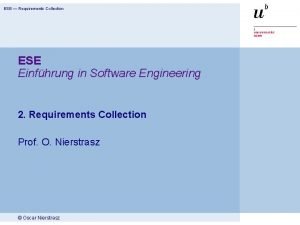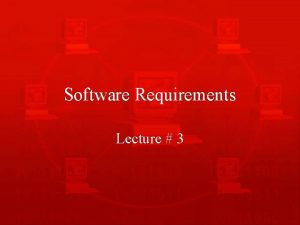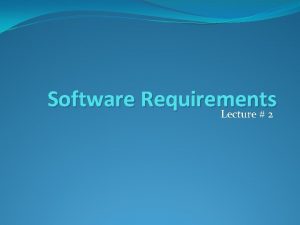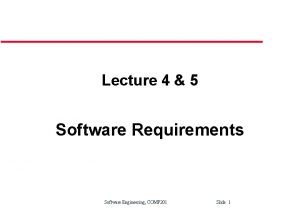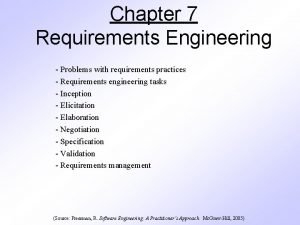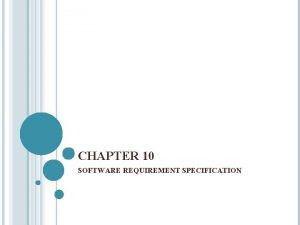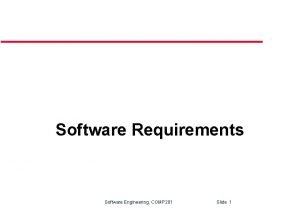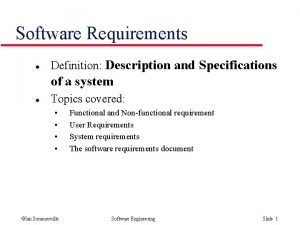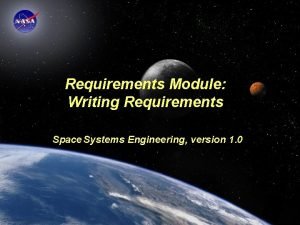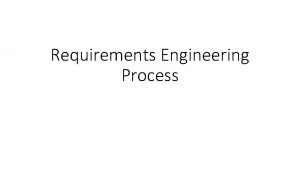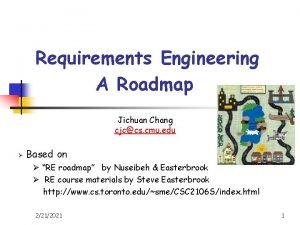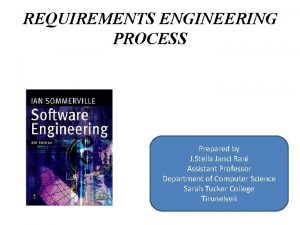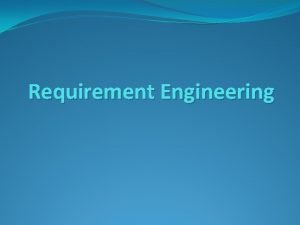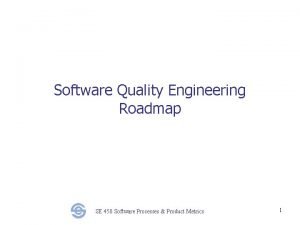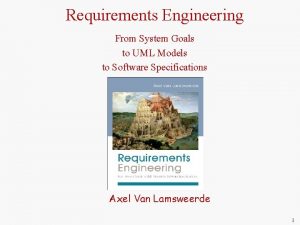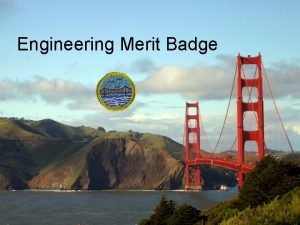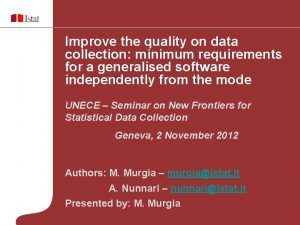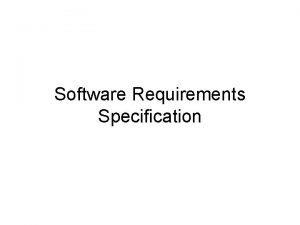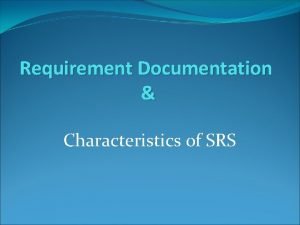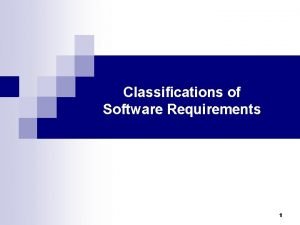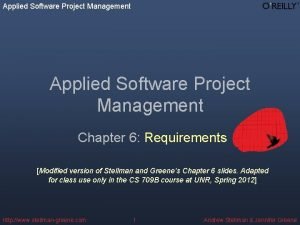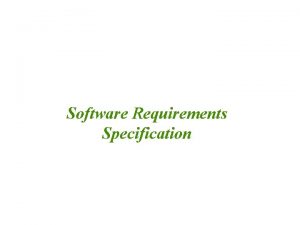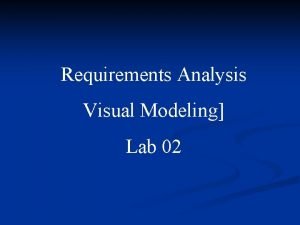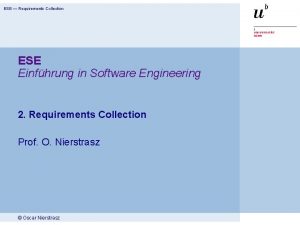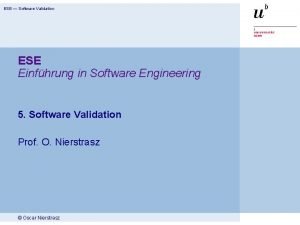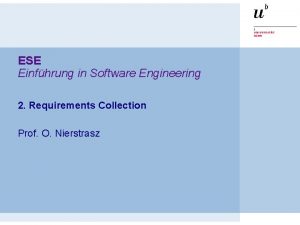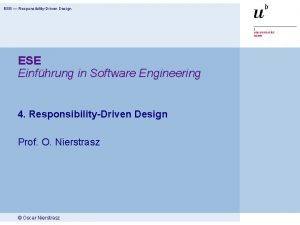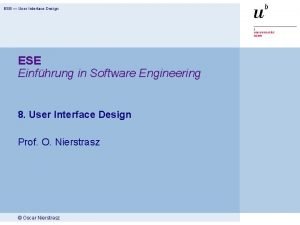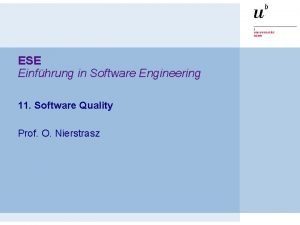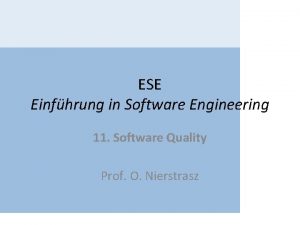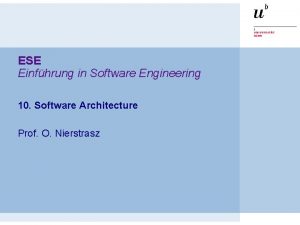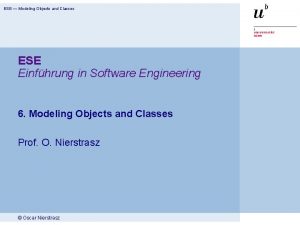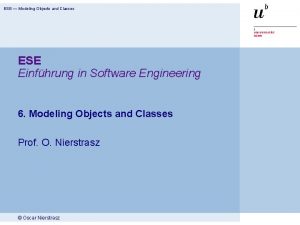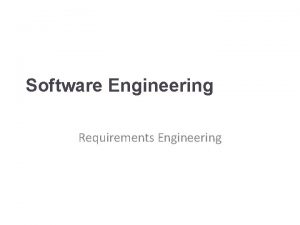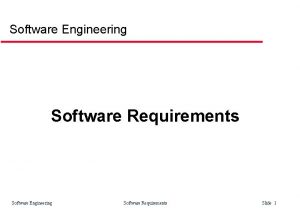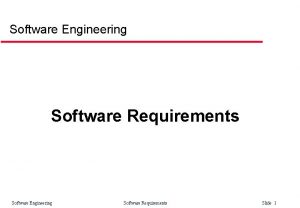ESE Einfhrung in Software Engineering 2 Requirements Collection












































- Slides: 44

ESE Einführung in Software Engineering 2. Requirements Collection Prof. O. Nierstrasz

ESE — Requirements Collection © Oscar Nierstrasz http: //en. wikipedia. org/wiki/Fair_use ESE 2. 2

ESE — Requirements Collection Roadmap > The Requirements Engineering Process > Use Cases > Functional and non-functional requirements > Evolutionary and throw-away prototyping > Requirements checking and reviews © Oscar Nierstrasz ESE 2. 3

ESE — Requirements Collection Sources > > > Software Engineering, I. Sommerville, 7 th Edn. , 2004. Software Engineering — A Practitioner’s Approach, R. Pressman, Mc-Graw Hill, 5 th Edn. , 2001. Objects, Components and Frameworks with UML, D. D'Souza, A. Wills, Addison-Wesley, 1999 © Oscar Nierstrasz ESE 2. 4

ESE — Requirements Collection Roadmap > The Requirements Engineering Process > Use Cases > Functional and non-functional requirements > Evolutionary and throw-away prototyping > Requirements checking and reviews © Oscar Nierstrasz ESE 2. 5

ESE — Requirements Collection © Oscar Nierstrasz ESE 2. 6

ESE — Requirements Collection Electronic Time Schedule “So, basically we need a form for the time schedule that can be distributed by e. Mail, a place (html) where I can deposit these forms after they have been filled out, and an algorithm that calculates a few possible meeting times, possibly setting priorities to certain persons of each committee (since there will always be some time schedule overlaps). It would also be great if there were a way of checking whether everybody of the relevant committee has really sent their time schedule back and at the same time listing all the ones who have failed to do so. An automatic invitation letter for the committee meeting to all the persons involved, generated through this programme, would be even a further asset. ” How can we transform this description into a requirements specification? © Oscar Nierstrasz ESE 2. 7

ESE — Requirements Collection The Requirements Engineering Process ©© Ian. Oscar Sommerville 2000 Nierstrasz ESE 2. 8

ESE — Requirements Collection Requirements Engineering Activities Feasibility study Determine if the user needs can be satisfied with the available technology and budget. Requirements analysis Find out what system stakeholders require from the system. Requirements definition Define the requirements in a form understandable to the customer. Requirements specification Define the requirements in detail. (Written as a contract between client and contractor. ) “Requirements are for users; specifications are for analysts and developers. ” © Oscar Nierstrasz ESE 2. 9

ESE — Requirements Collection Requirements Analysis Sometimes called requirements elicitation or requirements discovery Technical staff work with customers to determine > the application domain, > the services that the system should provide and > the system’s operational constraints. Involves various stakeholders: > e. g. , end-users, managers, engineers involved in maintenance, domain experts, trade unions, etc. © Oscar Nierstrasz ESE 2. 10

ESE — Requirements Collection © Oscar Nierstrasz http: //en. wikipedia. org/wiki/Fair_use ESE 2. 11

ESE — Requirements Collection Problems of Requirements Analysis Various problems typically arise: — Stakeholders don’t know what they really want — Stakeholders express requirements in their own terms — Different stakeholders may have conflicting requirements — Organisational and political factors may influence the system requirements — The requirements change during the analysis process. — New stakeholders may emerge. © Oscar Nierstrasz ESE 2. 12

ESE — Requirements Collection Impedance Mismatches

ESE — Requirements Collection Requirements evolution > Requirements always evolve as a better understanding of user needs is developed and as the organisation’s objectives change > It is essential to plan for change in the requirements as the system is being developed and used © Oscar Nierstrasz ESE 2. 14

ESE — Requirements Collection The Requirements Analysis Process ©© Ian. Oscar Sommerville 2000 Nierstrasz ESE 2. 15

ESE — Requirements Collection Roadmap > The Requirements Engineering Process > Use Cases > Functional and non-functional requirements > Evolutionary and throw-away prototyping > Requirements checking and reviews © Oscar Nierstrasz ESE 2. 16

ESE — Requirements Collection Use Cases and Scenarios A use case is the specification of a sequence of actions, including variants, that a system (or other entity) can perform, interacting with actors of the system”. — e. g. , buy a DVD through the internet A scenario is a particular trace of action occurrences, starting from a known initial state. — e. g. , connect to my. DVD. com, go to the “search” page . . . © Oscar Nierstrasz ESE 2. 17

ESE — Requirements Collection Use Cases and Viewpoints. . . Stakeholders represent different problem viewpoints. — Interview as many different kinds of stakeholders as possible/necessary — Translate requirements into use cases or “stories” about the desired system involving a fixed set of actors (users and system objects) — For each use case, capture both typical and exceptional usage scenarios Users tend to think about systems in terms of “features”. — You must get them to tell you stories involving those features. — Use cases and scenarios can tell you if the requirements are complete and consistent! © Oscar Nierstrasz ESE 2. 18

ESE — Requirements Collection Unified Modeling Language UML is the industry standard for documenting OO models Class Diagrams visualize logical structure of system in terms of classes, objects and relationships show external actors and use cases they participate in visualize temporal message ordering of a Sequence Diagrams concrete scenario of a use case Use Case Diagrams Collaboration (Communication) Diagrams State Diagrams © Oscar Nierstrasz visualize relationships of objects exchanging messages in a concrete scenario specify the abstract states of an object and the transitions between the states ESE 2. 19

ESE — Requirements Collection Use Case Diagrams More on this later … © Oscar Nierstrasz ESE 2. 20

ESE — Requirements Collection Sequence Diagrams © Oscar Nierstrasz ESE 2. 21

ESE — Requirements Collection Writing Requirements Definitions Requirements definitions usually consist of natural language, supplemented by (e. g. , UML) diagrams and tables. Three types of problems can arise: — Lack of clarity: It is hard to write documents that are both precise and easy-to-read. — Requirements confusion: Functional and non-functional requirements tend to be intertwined. — Requirements amalgamation: Several different requirements may be expressed together. © Oscar Nierstrasz ESE 2. 22

ESE — Requirements Collection Roadmap > The Requirements Engineering Process > Use Cases > Functional and non-functional requirements > Evolutionary and throw-away prototyping > Requirements checking and reviews © Oscar Nierstrasz ESE 2. 23

ESE — Requirements Collection Functional and Non-functional Requirements Functional requirements describe system services or functions — Compute sales tax on a purchase — Update the database on the server. . . Non-functional requirements are constraints on the system or the development process Non-functional requirements may be more critical than functional requirements. If these are not met, the system is useless! © Oscar Nierstrasz ESE 2. 24

ESE — Requirements Collection Non-functional Requirements Product requirements: specify that the delivered product must behave in a particular way e. g. execution speed, reliability, etc. Organisational requirements: are a consequence of organisational policies and procedures e. g. process standards used, implementation requirements, etc. External requirements: arise from factors which are external to the system and its development process e. g. interoperability requirements, legislative requirements, etc. © Oscar Nierstrasz ESE 2. 25

ESE — Requirements Collection Types of Non-functional Requirements ©© Ian. Oscar Sommerville 2000 Nierstrasz ESE 2. 26

ESE — Requirements Collection Examples of Non-functional Requirements Product requirement Organisational requirement External requirement © Oscar Nierstrasz It shall be possible for all necessary communication between the APSE and the user to be expressed in the standard Ada character set. The system development process and deliverable documents shall conform to the process and deliverables defined in XYZCo-SP-STAN-95. The system shall provide facilities that allow any user to check if personal data is maintained on the system. A procedure must be defined and supported in the software that will allow users to inspect personal data and to correct any errors in that data. ESE 2. 27

ESE — Requirements Collection Requirements Verifiability Requirements must be written so that they can be objectively verified. Imprecise: — The system should be easy to use by experienced controllers and should be organised in such a way that user errors are minimised. Terms like “easy to use” and “errors shall be minimised” are useless as specifications. Verifiable: — Experienced controllers should be able to use all the system functions after a total of two hours training. After this training, the average number of errors made by experienced users should not exceed two per day. © Oscar Nierstrasz ESE 2. 28

ESE — Requirements Collection Precise Requirements Measures (I) Property Speed Size Ease of use © Oscar Nierstrasz Measure Processed transactions/second User/Event response time Screen refresh time K Bytes; Number of RAM chips Training time Rate of errors made by trained users Number of help frames ESE 2. 29

ESE — Requirements Collection Precise Requirements Measures (II) Property Reliability Robustness Portability © Oscar Nierstrasz Measure Mean time to failure Probability of unavailability Rate of failure occurrence Time to restart after failure Percentage of events causing failure Probability of data corruption on failure Percentage of target dependent statements Number of target systems ESE 2. 30

ESE — Requirements Collection Roadmap > The Requirements Engineering Process > Use Cases > Functional and non-functional requirements > Evolutionary and throw-away prototyping > Requirements checking and reviews © Oscar Nierstrasz ESE 2. 31

ESE — Requirements Collection Prototyping Objectives The objective of evolutionary prototyping is to deliver a working system to end-users. — Development starts with the requirements that are best understood. The objective of throw-away prototyping is to validate or derive the system requirements. — Prototyping starts with that requirements that are poorly understood. © Oscar Nierstrasz ESE 2. 32

ESE — Requirements Collection Evolutionary Prototyping > Must be used for systems where the specification cannot be developed in advance. — e. g. , AI systems and user interface systems > Based on techniques which allow rapid system iterations. — e. g. , executable specification languages, VHL languages, 4 GLs, component toolkits > Verification is impossible as there is no specification. — Validation means demonstrating the adequacy of the system. © Oscar Nierstrasz ESE 2. 33

ESE — Requirements Collection Throw-away Prototyping > Used to reduce requirements risk — The prototype is developed from an initial specification, delivered for experiment then discarded > The throw-away prototype should not be considered as a final system — Some system characteristics may have been left out — (e. g. , platform requirements may be ignored) — There is no specification for long-term maintenance — The system will be poorly structured and difficult to maintain © Oscar Nierstrasz ESE 2. 34

ESE — Requirements Collection Roadmap > The Requirements Engineering Process > Use Cases > Functional and non-functional requirements > Evolutionary and throw-away prototyping > Requirements checking and reviews © Oscar Nierstrasz ESE 2. 35

ESE — Requirements Collection Requirements Checking Validity Consistency Completeness Realism © Oscar Nierstrasz Does the system provide the functions which best support the customer’s needs? Are there any requirements conflicts? Are all functions required by the customer included? Can the requirements be implemented given available budget and technology? ESE 2. 36

ESE — Requirements Collection Requirements Reviews > Regular reviews should be held while the requirements definition is being formulated > Both client and contractor staff should be involved in reviews > Reviews may be formal (with completed documents) or informal. — Good communications between developers, customers and users can resolve problems at an early stage © Oscar Nierstrasz ESE 2. 37

ESE — Requirements Collection Review checks Verifiability Is the requirement realistically testable? Comprehensibility Is the requirement properly understood? Traceability Is the origin of the requirement clearly stated? Adaptability Can the requirement be changed without a large impact on other requirements? © Oscar Nierstrasz ESE 2. 38

ESE — Requirements Collection Sample Requirements Review Checklist > > > > Does the (software) product have a succinct name, and a clearly described purpose? Are the characteristics of users and of typical usage mentioned? (No user categories missing. ) Are all external interfaces of the software explicitly mentioned? (No interfaces missing. ) Does each specific requirement have a unique identifier ? Is each requirement atomic and simply formulated ? (Typically a single sentence. Composite requirements must be split. ) Are requirements organized into coherent groups ? (If necessary, hierarchical; not more than about ten per group. ) Is each requirement prioritized ? (Is the meaning of the priority levels clear? ) Are all unstable requirements marked as such? (TBC=`To Be Confirmed', TBD=`To Be Defined') http: //wwwis. win. tue. nl/2 M 390/rev_req. html © Oscar Nierstrasz ESE 2. 39

ESE — Requirements Collection Sample Requirements Review Checklist > > > > Is each requirement verifiable (in a provisional acceptance test)? (Measurable: where possible, quantify; capacity, performance, accuracy) Are the requirements consistent ? (Non-conflicting. ) Are the requirements sufficiently precise and unambiguous ? (Which interfaces are involved, who has the initiative, who supplies what data, no passive voice. ) Are the requirements complete? Can everything not explicitly constrained indeed be viewed as developer freedom? Is a product that satisfies every requirement indeed acceptable? (No requirements missing. ) Are the requirements understandable to those who will need to work with them later? Are the requirements realizable within budget? Do the requirements express actual customer needs (in the language of the problem domain), rather than solutions (in developer jargon)? http: //wwwis. win. tue. nl/2 M 390/rev_req. html © Oscar Nierstrasz ESE 2. 40

ESE — Requirements Collection Traceability To protect against changes you should be able to trace back from every system component to the original requirement that caused its presence C 1 req 2 C 2 … x x … © Oscar Nierstrasz Cm x … reqn … x x x • A software process should help you keep this virtual table up-to -date • Simple techniques may be quite valuable (naming conventions, . . . ) ESE 2. 41

ESE — Requirements Collection What you should know! > What is the difference between requirements analysis > > > and specification? Why is it hard to define and specify requirements? What are use cases and scenarios? What is the difference between functional and nonfunctional requirements? What’s wrong with a requirement that says a product should be “user-friendly”? What’s the difference between evolutionary and throwaway prototyping? © Oscar Nierstrasz ESE 2. 42

ESE — Requirements Collection Can you answer the following questions? > Why isn’t it enough to specify requirements as a set of > > > desired features? Which is better for specifying requirements: natural language or diagrams? How would you prototype a user interface for a webbased ordering system? Would it be an evolutionary or throw-away prototype? What would you expect to gain from the prototype? How would you check a requirement for “adaptability”? © Oscar Nierstrasz ESE 2. 43

ESE — Requirements Collection License > http: //creativecommons. org/licenses/by-sa/3. 0/ Attribution-Share. Alike 3. 0 Unported You are free: to Share — to copy, distribute and transmit the work to Remix — to adapt the work Under the following conditions: Attribution. You must attribute the work in the manner specified by the author or licensor (but not in any way that suggests that they endorse you or your use of the work). Share Alike. If you alter, transform, or build upon this work, you may distribute the resulting work only under the same, similar or a compatible license. For any reuse or distribution, you must make clear to others the license terms of this work. The best way to do this is with a link to this web page. Any of the above conditions can be waived if you get permission from the copyright holder. Nothing in this license impairs or restricts the author's moral rights. © Oscar Nierstrasz ESE 2. 44
 Ese requirements
Ese requirements Domain requirements
Domain requirements Inverse requirements
Inverse requirements High level requirements
High level requirements Requirements discovery techniques in software engineering
Requirements discovery techniques in software engineering Requirement engineering process
Requirement engineering process What is domain requirements in software engineering
What is domain requirements in software engineering User requirements
User requirements Seven distinct tasks to requirements engineering
Seven distinct tasks to requirements engineering Srs in software engineering
Srs in software engineering System requirements in software engineering
System requirements in software engineering Source and sink analysis in software engineering
Source and sink analysis in software engineering What is domain requirements
What is domain requirements Computer based system engineering
Computer based system engineering Forward engineering and reverse engineering
Forward engineering and reverse engineering Landsat collection 1 vs collection 2
Landsat collection 1 vs collection 2 Documents against payment
Documents against payment Software maintenance process models ppt
Software maintenance process models ppt Who invented software engineering
Who invented software engineering Metrics computer science
Metrics computer science Software crisis of 1960s
Software crisis of 1960s Halstead software metrics example
Halstead software metrics example Real time software design in software engineering
Real time software design in software engineering Software design fundamentals in software engineering
Software design fundamentals in software engineering Non functional requirements
Non functional requirements Requirements writing for system engineering
Requirements writing for system engineering Requirements engineering
Requirements engineering Jichuan chang
Jichuan chang Chapter 4 requirements engineering
Chapter 4 requirements engineering Initiating the requirements engineering process
Initiating the requirements engineering process Uva drop deadline engineering
Uva drop deadline engineering Feasibility studies for requirements engineering process
Feasibility studies for requirements engineering process What is inception in software engineering
What is inception in software engineering Good practices for requirements engineering
Good practices for requirements engineering Requirements engineering: a roadmap
Requirements engineering: a roadmap Requirements engineering uml
Requirements engineering uml Engineering merit badge requirements
Engineering merit badge requirements Data collection software
Data collection software Requirement specification
Requirement specification Modifiability in srs is
Modifiability in srs is Persyaratan spesifikasi perangkat
Persyaratan spesifikasi perangkat Software requirements types
Software requirements types Project management software requirements checklist
Project management software requirements checklist Ieee srs
Ieee srs Visual models for software requirements
Visual models for software requirements
